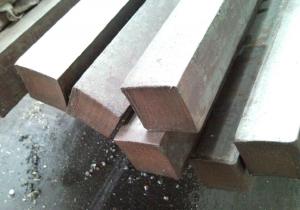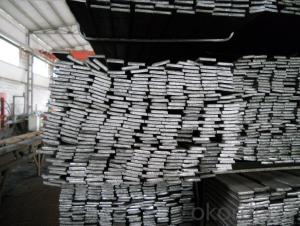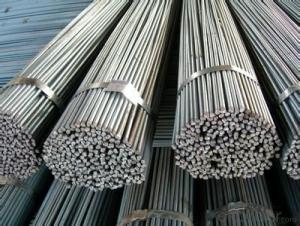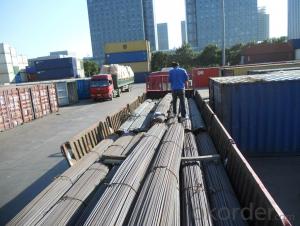0.3% De Chemial Element Cr For Steel Square Bar
- Loading Port:
- China main port
- Payment Terms:
- TT OR LC
- Min Order Qty:
- 25 m.t.
- Supply Capability:
- 10000 m.t./month
OKorder Service Pledge
OKorder Financial Service
You Might Also Like
Product Description
There are two types of Square Bar, one is hot rolled square bar and other one is cold drawn square bar. Our principal products is hot rolled square bar. We dedicate to products with material Q195 and Q235. We offer products with high quality and low price.
Specifications
-Standard: GB,
-Grade: Q195/Q235 or equivalent.
-Chemical Composition:
Standard | Grade | Element (%) | ||||
C | Mn | S | P | Si | ||
GB | Q195 | 0.06~0.12 | 0.25~0.50 | ≤0.050 | ≤0.045 | ≤0.30 |
GB | Q235B | 0.12~0.20 | 0.30~0.70 | ≤0.045 | ≤0.045 | ≤0.30 |
-Mechanical Properties:
Mechanical Properties | Grade | Steel diameter(mm) | |||
≤16 | 16~40 | 40~60 | 60~100 | ||
Yield Point Δs/MPa | Q195 | ≥195 | ≥185 | - | - |
Q235 | 235 | 225 | 215 | 205 | |
Tensile Strength | Q195 | 315~390 | |||
Q235 | 375~500 | ||||
Elongation δ5% | Q195 | ≥33 | ≥32 | - | - |
Q235 | 26 | 25 | 24 | 23 | |
Measures (Big measures):
(Section of Hot-rolled Square Steel Bar)
-Length of a side and Theoretical weight of Square Bar (Big measures).
Length of a side(mm) | Theoretical weight(kg/m) | Length of a side(mm) | Theoretical weight(kg/m) |
53 | 22.05 | 80 | 50.24 |
56 | 24.61 | 85 | 56.72 |
60 | 28.26 | 90 | 63.59 |
63 | 31.16 | 95 | 70.85 |
70 | 38.49 | 100 | 78.50 |
75 | 44.16 |
Notes:
1, The theoretical weights in the list, base on the density of 7.85 g/cm3.
2, Formula for theoretical weight of Square bar: a(length of a side) * a * 0.00785
3, The numbers with *mean that they are not regular or we don’t offer them.
-Regular length of Square Bar:
Steel | Length of a side (mm) | Length of steel (m) |
Normal steel | < 25 | 4~10 |
> 25 | 3~9 | |
Steel of high quality | All measure | 2~6 |
Tool steel >75 | 1~6 |
Usage/Applications
-The Square Steel is normally used as structure steel.
-Row material for other structure steel like steel angles, channels, I-beams, H-beams, etc…
-Row material for steel pipes.
Packaging & Delivery
-Packing Detail:
1, The products can be packed in bundles by steel wires.
2, The weight of each bundle no exceed normally 3 tons.
-Marks: We make tag marks and color marks for each bundle. The tag marks with white background and red company log will be tied up to each bundle. The information is usually including basic information of company and products like product name, specification, etc...and other information required by customers. As for color marks, we will paint both ends of each bundles to make sure that it will be more convenient for customers to distinguish theme from other products.
-Delivery Detail: 30~45 working days after receive buyer’s T.T. or L/C.
Payment:
-Invoicing on theoretical weight or actual weight as customer’s request.
-FOB, CFR or CIF.
-Regular terms of payment:
1, 30% payment in advance, the remaining balance (70% payment) against the copy of B/L.
2, 30% payment in advance, the remaining balance (70% L/C) against the copy of B/L.
3, Negotiable.
-The payment terms will be written in contraction detailed.
- Q:What are some common techniques for using a steel square in furniture repair?
- Some common techniques for using a steel square in furniture repair include measuring and marking accurate angles, checking for squareness and straightness, ensuring proper alignment during assembly, and verifying the levelness of surfaces.
- Q:What are the common applications of a steel square in metal fabrication?
- A steel square, also known as a framing square or a carpenter's square, is commonly used in metal fabrication for various applications. Some of the common uses include measuring and marking right angles, checking the squareness of corners and edges, laying out and marking cuts, and aligning and squaring components during fabrication. It is a versatile tool that helps ensure accuracy and precision in metalwork.
- Q:Can a steel square be used for measuring the width of a window frame?
- Yes, a steel square can be used for measuring the width of a window frame.
- Q:How do you use a steel square to ensure the correct angle for a dovetail joint?
- To use a steel square to ensure the correct angle for a dovetail joint, you need to follow a few simple steps. First, determine the angle you want to achieve for your dovetail joint. This is typically a 1:8 or 1:6 angle, with the 1:8 being more common. Next, place the steel square on the edge of the board that you will be cutting the dovetail joint into. The long side of the square should be aligned with the edge of the board, while the short side should be perpendicular to it. Now, using a pencil or a marking knife, mark a line along the short side of the square. This line will be your reference for cutting the dovetail joint. If you are using a 1:8 angle, the line should be 1/8th of an inch from the edge of the board. Similarly, for a 1:6 angle, the line should be 1/6th of an inch from the edge. You can then use this line as a guide for cutting the dovetail joint. Place the square on the edge of the board each time you need to mark another cut or make a measurement to ensure accuracy. By using a steel square in this manner, you can ensure that your dovetail joint will have the correct angle, resulting in a strong and precise joint. Remember to always double-check your measurements and make test cuts before finalizing your joint.
- Q:How do you use a steel square to determine the angle of a rabbet cut?
- In order to determine the angle of a rabbet cut using a steel square, there are a few straightforward steps that need to be followed. To begin, position the steel square against the edge of the rabbet cut, ensuring that one arm of the square is resting on the surface that you plan to cut. It is important to align the square correctly and firmly against the edge. Following this, utilize a pencil or scribe to draw a line along the other arm of the square. This line represents the desired cutting angle. Afterwards, measure the angle you have just marked by employing a protractor or angle finder. Simply place the protractor or angle finder against the line and read the measurement. Subsequently, you can transfer this angle to your saw by aligning the saw blade with the marked line on the steel square. Before making the cut, it is crucial to securely fasten the material you are working with. By utilizing a steel square to ascertain the angle of a rabbet cut, you can guarantee accuracy and precision in your woodworking endeavors.
- Q:How do you use a steel square to determine the slope of a gutter?
- In order to determine the slope of a gutter using a steel square, the following steps should be followed: 1. Begin by measuring the width of the gutter using the outer edges of the steel square. Make sure that the square is firmly pressed against the gutter. 2. Proceed by positioning one side of the steel square against the bottom of the gutter, ensuring that it is level. The other side of the square should extend vertically towards the top edge of the gutter. 3. Verify that the steel square is perfectly vertical by using a level. If necessary, make adjustments. 4. Once the steel square is aligned correctly, examine the measurement markings on the square. The vertical side of the square indicates the rise or fall, while the horizontal side represents the run or distance. 5. Take note of the measurement where the horizontal side of the square intersects with the top edge of the gutter. This measurement will provide you with the rise or fall of the gutter. 6. To calculate the slope, divide the measurement of the rise or fall by the width of the gutter. This will yield the slope ratio, which can be expressed as a percentage or a ratio (e.g., 1:100). Utilizing a steel square to determine the slope of a gutter is an effective technique as it enables precise measurements and guarantees the proper installation of the gutter for efficient drainage.
- Q:How do you use a steel square to ensure the correct angle for a finger joint?
- To use a steel square to ensure the correct angle for a finger joint, you would start by marking the desired angle on the edge of the wood. Then, place one arm of the steel square against the edge of the wood and align the other arm with the angle mark. Finally, use a pencil or marking knife to trace along the edge of the steel square, creating a precise guideline for cutting the finger joint.
- Q:Can a steel square be used for checking the squareness of a planer bed?
- Yes, a steel square can be used for checking the squareness of a planer bed. A steel square is a tool with a right angle that can be used to test if two surfaces are perpendicular to each other. In the case of a planer bed, which should ideally have a flat and square surface, a steel square can be placed on the bed and compared against its edges. If the steel square aligns perfectly with the edges of the planer bed, then it can be concluded that the bed is square. However, it is important to ensure that the steel square being used is accurate and has been calibrated properly to obtain accurate results.
- Q:Can a steel square be used for checking the flatness of a countertop?
- No, a steel square cannot be used for checking the flatness of a countertop.
- Q:How do you use a steel square for marking stair tread and riser dimensions?
- To use a steel square for marking stair tread and riser dimensions, follow these steps: 1. Start by measuring the total rise of the stairs, which is the vertical distance from the top of the landing to the finished floor level. Note down this measurement. 2. Next, determine the desired height of each riser. This can be calculated by dividing the total rise by the number of risers. For example, if the total rise is 48 inches and you want 6 risers, each riser should be 48/6 = 8 inches high. 3. Now, take your steel square and place it on a flat surface. Position the long edge of the square vertically, ensuring it is perpendicular to the surface. 4. Align the bottom corner of the square with the edge of the material you are marking, such as a piece of wood or the stringer on the stairs. 5. With the square held firmly against the material, use a pencil or marking knife to draw a line along the inside edge of the square. 6. For marking the tread dimensions, use the inside edge of the square to measure and mark the desired depth of each tread. The tread depth can be calculated by subtracting the riser height from the desired total run (the horizontal distance covered by the stairs). For instance, if you want a total run of 72 inches and have 6 risers, each tread should be 72/6 = 12 inches deep. 7. Repeat this process for each riser and tread, ensuring that the square remains held firmly against the material to maintain accuracy. Using a steel square for marking stair tread and riser dimensions allows for precise and consistent measurements, resulting in well-balanced and safe stairs. Remember to always double-check your measurements before cutting or installing any materials.
1. Manufacturer Overview |
|
|---|---|
| Location | |
| Year Established | |
| Annual Output Value | |
| Main Markets | |
| Company Certifications | |
2. Manufacturer Certificates |
|
|---|---|
| a) Certification Name | |
| Range | |
| Reference | |
| Validity Period | |
3. Manufacturer Capability |
|
|---|---|
| a)Trade Capacity | |
| Nearest Port | |
| Export Percentage | |
| No.of Employees in Trade Department | |
| Language Spoken: | |
| b)Factory Information | |
| Factory Size: | |
| No. of Production Lines | |
| Contract Manufacturing | |
| Product Price Range | |
Send your message to us
0.3% De Chemial Element Cr For Steel Square Bar
- Loading Port:
- China main port
- Payment Terms:
- TT OR LC
- Min Order Qty:
- 25 m.t.
- Supply Capability:
- 10000 m.t./month
OKorder Service Pledge
OKorder Financial Service
Similar products
New products
Hot products
Hot Searches
Related keywords


























